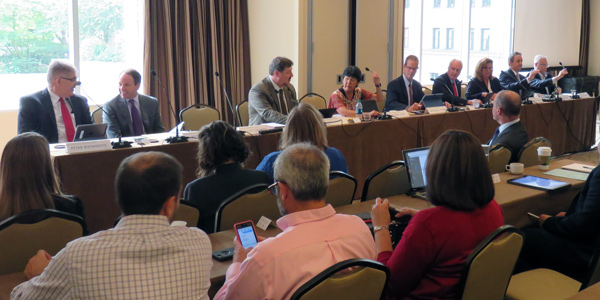By Jason Fordney
SEATTLE — The Western Energy Imbalance Market (EIM) Governing Body on Wednesday approved a CAISO proposal allowing market participants to take part in a program that models generator outages and the impact of remedial action schemes (RAS) on market operations.
The current market structure only addresses cases in which a transmission line goes down, potentially causing overflow on other lines. The new method reflects how the system will react to the loss of generation, CAISO Manager of Market Policy Design Brad Cooper said at the Governing Body meeting.
“It should result in a much more efficient market solution than just using offline tools and manual actions,” Cooper said, and be “more efficient and transparent as to what is happening.” The CAISO Board of Governors will vote on the rule changes later this month, after reviewing a more comprehensive package that would bring the measures into the ISO’s day-ahead market. The changes must also be approved by FERC.
The ISO currently uses manual, out-of-market dispatches to manage generator contingencies and RAS, which are protective processes that automatically disconnect generators or load in order to prevent transmission line overload in the event that another line goes out. The new method will update the ISO’s security constrained economic dispatch by modeling the loss of generation within the dispatch, as well as modeling the loss of transmission and generation because of RAS operations. The program effectively incentivizes generator participation in RAS.
“The proposed changes result in an update to the congestion component of the locational marginal price so that it considers the cost of positioning the system to account for generator contingencies and remedial action scheme operations,” the ISO said in its final proposal. “A remedial action scheme-connected generator will potentially receive higher energy prices than generators not connected to a remedial action scheme at the same bus because a remedial action scheme-connected generator does not contribute to binding emergency limits.”
CAISO says the new method will better reflect congestion in localized prices and improve generator dispatch.
Market participants had some misgivings about the new functionality when it was unveiled by CAISO. (See Stakeholders Wary of CAISO Contingency Modeling.) The ISO first presented the proposal in an April 2016 issue paper and drafted a final draft proposal on July 25 of this year.
Allowing EIM entities to model generator contingencies and RAS falls within the Governing Body’s “primary” approval authority, while it approved the general design of the proposal under its “advisory” capacity. CAISO’s Market Surveillance Committee and Department of Market Monitoring support the new program.
Southern California Edison expressed concerns over what it considered to be the anomalous effects of the changes on CAISO’s interconnection process — but that would not apply to EIM entities not subject to that process, Cooper said.
“We disagree with Southern California Edison in any case,” regarding the effects of the new functionalities, he said.
Governing Body Chairman Doug Howe asked if the modeling would be totally voluntary and queried Cooper as to the trade-off between the benefit and cost of the proposal.
“That is something we consider in everything we develop,” Cooper said. “We are convinced that the benefits justify the costs.” He confirmed the program is voluntary and is part of larger improvements to market operations.





